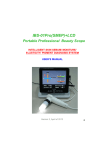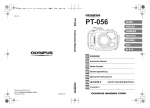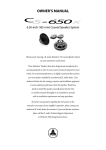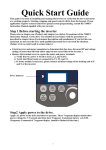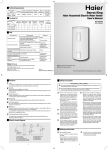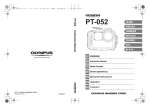Download User`s Manual -BS-88E & BS-2000
Transcript
BS-88E / BS-2000 Beauty Scope SKIN & HAIR ANALYSER USER’S MANUAL BS-88E BS-2000 0 User’s Manual Congratulations on your purchase of Video Microscope. We believe the versatility and ease of use of this product will lead you to obtain more success in business deals and create more profit for you. The Video Microscope is guided cool light surrounding the lens and automatically provides the best illumination to enable you to obtain the optimum viewing angle and color of the target object on the video monitor. Image retention on hard copy and image storage are possible by simply connecting the video output of Video Microscope directly to an optional Color Video Printer, Video Tape Recorder (VTR), or Personal Computer (PC with appropriate image capture care installed). 1. ACCESSORIES 1-1 Standard accessories: Item Q’ty Description 1 1 Control box 2 1 Handy Probe 3 1 Probe Holder 4 1 RCA (RCA-RCA) video cable 5 1 Power Adaptor (100V-240V) 6 1 User’s manual 1-2 Optional accessories: Item Q’ty Description 1 1 1x Lens (for styling purpose) 2 1 1-5x vari-mag. lens (for full face/body, half body, partial face) 3 1 50x lens (for surface skin inspection) 4 1 30x or 50x polarized lens (for surface/deeper layer skin check) 5 1 200x lens (for hair, scalp inspection) 6 1 650x lens (for hair cuticle inspection) 7 1 MB-88A memory board for 1 & 2 split frames freeze function 8 1 Black Carrying Case 1 2. FRONT / REAR PANEL & PROBE (Front Panel) Freeze button Probe holder Power switch MEMORY 1 2 Memory button for 1 frame or 2 split frames freeze switchable (optional function) (Rear Panel) Cooling fan Video Output DC input 2 3. SYSTEM BLOCK DIAGRAM AC/DC Converter (for connecting to Control box) Video output (for RCA Phone jack) connecting to monitor’s video input 3 4. ATTACHING LENS TO HANDY PROBE 4-1 ATTACHING LENS TO HANDY PROBE (1) Take off the anti-dust cover of the handy probe (2) Find the short post on the lens Short post (3) Look at the front side of handy probe, you will find there’s a “︵” shape slot. “︵" slot (4) Match (plug in) the post to the “︵” shape slot to ensure they are fully combined. Turn clockwise to screw on the lens, anti-clockwise to screw off the lens. 4 Step 1 Step 2 Step 3 Step 4 4-2 Place the probe holder on the control box Step 1 Step 2 Step 3 5 5. OPERATION 5-1 Installation is now completed. Turn the power switches of both the unit and your monitor to “ON” position. 5-2 Lens with a contact type illumination head is intended to be placed on or held just above the viewing object, Then you will get a vivid image on the monitor. 6. OPTIONAL FUNCTIONS 6-1 Freeze function --- One or two split frames freeze function switchable (with memory board for 1 or 2 split frames freeze) 1). One frame freeze Switch the memory button to “1” , then you can press the freeze button (on handy probe) to freeze image; to release the frozen image, just press the button again. 2). Two split frames freeze Switch the memory button to “2”, then you can follow the procedures to get 2 split frames: Freeze button 1st freeze 1st freeze live picture 2nd freeze 1st press 2nd press 3rd press (The split frames will be cleared and you can restart the freeze function.) Remark: (1) For the 1st freeze picture, you should seize the originally central part image of the full screen to get the 1/2 split frame 6 6-2 Polarized lens You can rotate the black rubber ring anti-clockwise to make surface skin inspection; rotate the black rubber ring clockwise you can make deeper layer skin inspection. Polarized inspection Surface inspection 6-3 650x lens (for hair cuticle inspection The focus for this lens is adjustable. You can rotate the black rubber ring clockwise or anti-clockwise to get the right focus to inspect the hair cuticle. 6-4 1-5x vari-mag. lens (for styling purpose) The focus range for this lens is adjustable. You can rotate the black rubber ring clockwise or anti-clockwise to get the right focus of full face/body, half body, or partial face) 7 * TROUBLE SHOOTING TROUBLE SHOOTING 1 Turn on the power switch, but no function, no light, no fan working. Check whether the AC adapter is properly connected. 2 The control box is in operation, but the handy probe doesn’t work (the handy probe cannot offer light or image). 1). Check the cable connection between the control box and the handy probe. 2). Check whether the lens is locked to its right position. (Make sure if the lamps inside the lens is light.) 3). Check if the AV signal cable between the control box and monitor is well-connected. 3 No image on the monitor screen: 1). Check whether the control box and monitor are powered on. 2). Check if the AV signal cable between the control box and monitor is well-connected. 3). Check whether the lens is locked to its right position. 4). Connect the unit to another monitor to judge the unit or monitor is out of order in order to repair it. 4 How to clear if there are dust pots on the camera of the handy probe? Take off the lens, wipe the small glass of the camera (inside the handy probe) with a cotton bar; or you can blow out the dust by using a small air pump. zPlease hold the handy probe toward ground direction to avoid new dusts. If the camera gets mildewed under humid condition, please contact the engineer to clean it. 5 The freeze function doesn’t work. (The unit must be equipped with this function) Check if the freeze button is OK. 6 While operating freeze function, the image on monitor screen is swaying & flashing. When you are pressing the freeze button, please keep your hands still (unmoved), then the image on the monitor screen will not sway or flash. 7 How to adjust when the image color is out of harmony? Please adjust following buttons of the monitor: (1) TINT (2) SHARPNESS (3) BRIGHTNESS (4) COLOR 8 While using the polarized lens to inspect surface skin (or deeper layer skin), why the lower part of the screen becomes darker (or brighter)? It’s because you do not rotate the black rubber ring to the bottom of its direction. So some light is covered (or some light is opened). You should completely rotate the black rubber ring of the polarized lens anti-clockwise (or clockwise). 8












